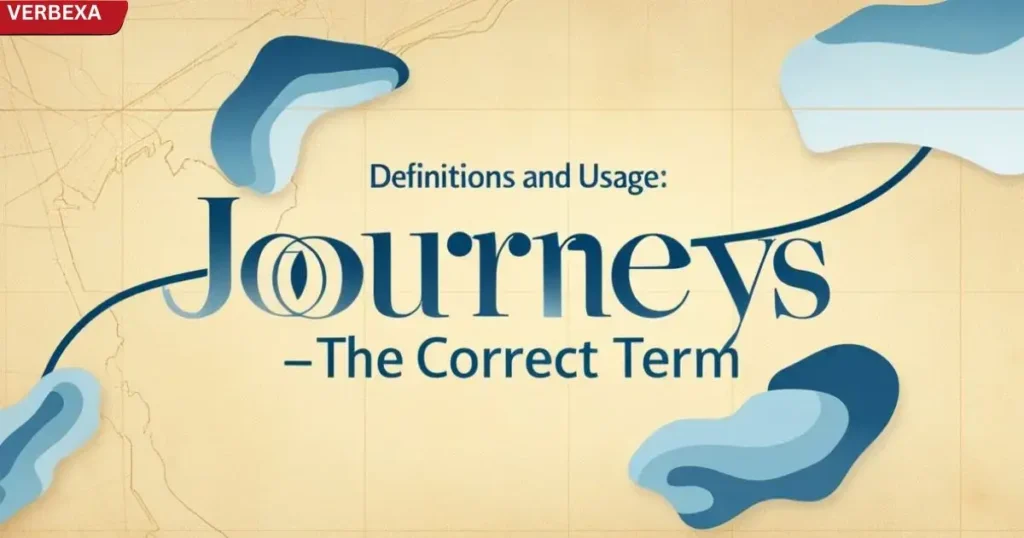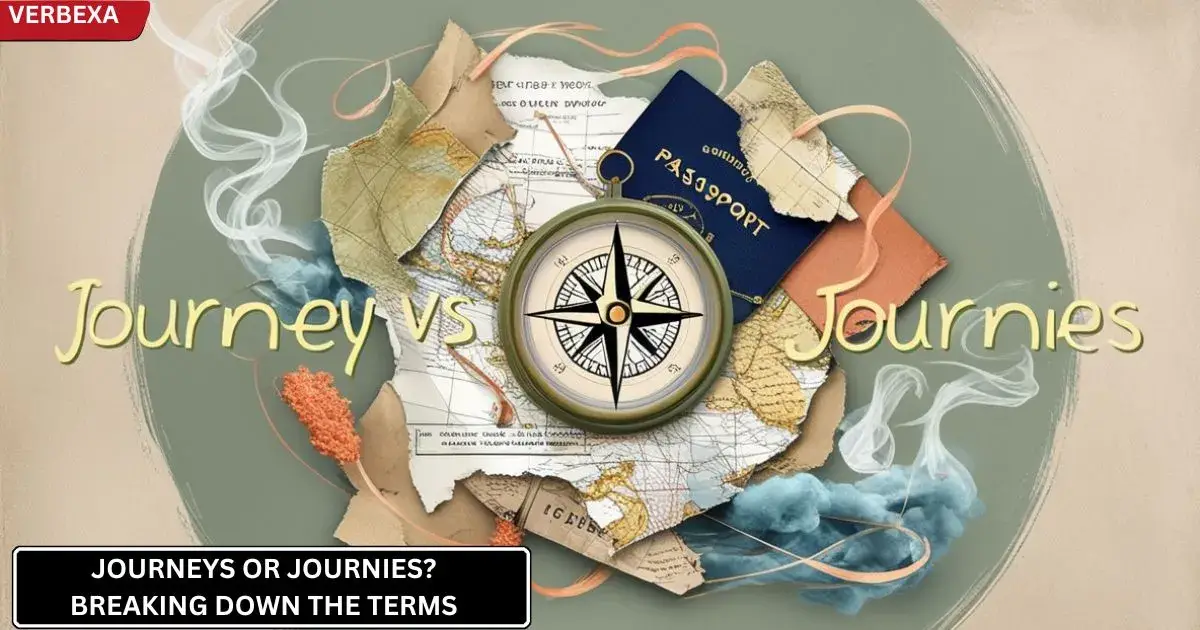In everyday conversations, writing, and even in professional contexts, it’s not uncommon to stumble upon terms that seem similar but are used in different ways. One such pair is “journeys” and “journies”. These words sound almost identical and have related meanings, but they are not interchangeable in all situations. Understanding when to use “journeys” and when “journies” is crucial for clear, accurate communication.
The confusion often arises because “journies” is a common misspelling of “journeys”. While “journeys” is the correct plural of journey, “journies” is simply an incorrect spelling frequently appearing in informal writing. This error can confuse readers and detract from the credibility of the writer. In this article, we’ll break down these terms, clarify their definitions, and provide examples to help you make the right choice. Whether you’re unsure of how to use the journey plural or wonder if “journeys or journies” is the correct form, this article will help clear up any confusion.
Understanding “Journeys” vs. “Journies”

Definitions and Usage: Journeys- The Correct Term

“Journeys” is the plural form of the noun “journey”, which refers to the act of traveling from one place to another, often over a long distance. A journey can also mean an experience or a process of development, not just physical travel.
- Definition: The plural of journey, “journeys”, refers to multiple trips or experiences.
- Examples:
- Literal: “We embarked on several journeys across Europe last summer.”
- Metaphorical: “Her career has been full of journeys of self-discovery.”
In the first example, “journeys” refers to physical trips, while in the second, it highlights personal growth experiences.
Understanding the Rule
The spelling rule for pluralizing words ending in ‘y’ depends on what comes before the ‘y’:
- If a vowel comes before the ‘y’ (as in journey, valley, toy), add ‘s’
- If a consonant comes before the ‘y’ (as in city, baby, fly), change ‘y’ to ‘i’ and add ‘es’
This explains why the incorrect form “journies” might seem plausible to some writers—they’re mixing up these two rules.
Journies: The Misspelling
“Journies” is a common misspelling of the correct plural form “journeys”. It appears often due to a misunderstanding of how to pluralize words ending in -ey. However, “journies” is not a valid word in standard English.
- Definition: There is no dictionary-recognized definition for “journies”. It is a misspelling and should be avoided in professional and formal writing.
- Grammatical Role: Since “journies” is a misspelling of “journeys”, it does not function grammatically as a legitimate word in the English language.
- Example of Misspelling:
- Incorrect: “We took many journeys to faraway places.”
- Corrected: “We took many journeys to unusual places.”
Understanding that “journeys” is the journey plural helps you avoid the common mistake of using “journies” in your writing.
Comparison Table: Journeys vs. Journies

| Aspect | Journeys | Journies |
|---|---|---|
| Definition | The plural of journey, meaning multiple trips or experiences. | A misspelling of “journeys.” |
| Correctness | Correct usage in all contexts. | Incorrect and should be avoided. |
| Grammatical Role | Noun, plural form of journey. | Not a valid word in standard English. |
| Example | “Our summer was filled with journeys to new places.” | “We had many journies over the years.” (Incorrect) |
| Usage Context | Use when referring to more than one trip, voyage, or metaphorical experience. | Avoid using “journies.” Always correct it to “journeys.” |
As illustrated, “journies or journeys” refers to the correct form when talking about more than one journey. Understanding these differences ensures clarity in writing.
When to Use Each Term
When to Use “Journeys”
You should always use “journeys” in both written and spoken English when referring to multiple instances of travel or experiences. This can include:
- Physical travel: Multiple trips taken over a period of time.
- Example: “Our journeys across Asia were unforgettable.”
- Metaphorical or figurative use: When discussing life experiences, personal growth, or any form of transformation.
- Example: “The journeys of self-discovery are often long and difficult.”
Using “journeys” when referring to the journey plural ensures you are using the term correctly in both formal and informal contexts.
When Not to Use “Journies”
Since “journies” is simply an incorrect spelling of “journeys”, it should never be used in formal writing, casual writing, or speech. If you find yourself using “journies”, it’s essential to recognize that this is a mistake and to correct it to “journeys”.
The confusion between “journies or journeys” is often caused by the common misconception that “journies” is a valid plural form of journey. But the truth is, “journeys” is the only acceptable plural form.
Everyday Usage Examples
To solidify your understanding, let’s look at some everyday examples of how “journeys” is used in sentences:
Physical Travel:
- “Their journeys across Europe lasted three months.”
- “Space journeys require extensive preparation and training.”
- “The explorers documented their journeys in detailed journals.”
Metaphorical Usage:
- “Career journeys often take unexpected turns.”
- “Our learning journeys continue throughout life.”
- “Different spiritual journeys lead people to various beliefs.”
Professional Context:
- “Customer journeys are crucial in marketing strategy.”
- “The company mapped out user journeys to improve the website.”
- “These healing journeys require patience and dedication.”
Incorrect Use of “Journies” (Common Misspelling)
- Incorrect: “She wrote a book about her many journies around the world.”
- Corrected: “She wrote a book about her many journeys around the world.”
The first sentence demonstrates the misspelling of “journeys” as “journies”, which should be corrected immediately for clarity and professionalism.
Why It’s Important to Avoid “Journies”
Using “journies” in your writing can undermine your credibility. Misspellings, especially common ones like this, may give readers the impression that you lack attention to detail or that you are not proficient in standard English. While casual conversations may forgive small errors, formal writing—whether in business, academic work, or journalism—requires adherence to proper spelling and grammar.
Ensuring that you use “journeys” correctly signals to your readers that you value accuracy and professionalism. It also makes your writing more precise and easier to understand.
Summary of Key Differences

- “Journeys” is the plural of journey, and is the correct term to use when referring to multiple trips or experiences.
- “Journies” is an incorrect spelling and should be avoided. It is simply a mistake in the spelling of “journeys”.
- Always use “journeys” in formal and informal writing to ensure clarity and correctness.
- When in doubt, check your spelling. If you’re referring to multiple instances of travel or metaphorical experiences, “journeys” is the appropriate word.
Understanding the difference between “journies or journeys” is essential to mastering English spelling and usage.
Frequently asked Questions
What is the correct plural of journey?
The correct plural of “journey” is “journeys”, not “journies.” It refers to multiple trips or experiences.
Is it career journeys or journies?
The correct form is “career journeys”. “Journies” is a common misspelling and should be avoided.
What is the meaning of Journies?
“Journies” is an incorrect spelling of “journeys” and has no valid meaning in standard English.
How do Americans spell journey?
Americans spell “journey” the same way as in British English, with no variation in this case.
What is a unique way to spell journey?
There isn’t a unique or alternate spelling for “journey” in standard English, other than its plural form “journeys”.
What words do Americans spell differently?
Americans often use different spellings, such as “color” instead of “colour”, and “theater” instead of “theatre.”
Conclusion: Mastering the Use of “Journeys” and “Journies”
The confusion between journeys or journies is a common error, but it’s easy to overcome once you understand the difference. “Journeys” is the correct plural of journey, and it should be used whenever you’re talking about more than one trip, voyage, or experience. “Journies”, on the other hand, is simply a misspelling that should be avoided.
By paying attention to this small detail in your writing, you can avoid confusion and ensure that your communication is clear, accurate, and professional. Whether you’re talking about your travels or reflecting on your life experiences, remember that “journeys” is the correct term to use.
So next time you’re writing about multiple trips or metaphorical experiences, be sure to use “journeys”—the correct and professional choice. Don’t get confused by the misconception of “journies or journeys”, and always remember that “journeys” is the only valid plural form.

This author is a passionate linguist and grammar enthusiast, dedicated to helping individuals master the art of language. With years of experience in teaching and editing, she brings clarity and precision to every sentence. Tina’s mission is to empower writers of all levels to express themselves with confidence and excellence.

